Nicholas I of Montenegro
Nikola I Petrović-Njegoš (Serbian Cyrillic: Никола I Петровић-Његош; 7 October [O.S. 25 September] 1841 – 1 March 1921) was the ruler of Montenegro from 1860 to 1918, reigning as prince from 1860 to 1910 and as the country's first and only king from 1910 to 1918.
| Nikola I Никола I | |||||
|---|---|---|---|---|---|
 | |||||
| King of Montenegro | |||||
| Reign | 28 August 1910 – 26 November 1918 | ||||
| Predecessor | Himself (as Prince of Montenegro) | ||||
| Successor | Title abolished | ||||
| Prince of Montenegro | |||||
| Reign | 13 August 1860 – 28 August 1910 | ||||
| Predecessor | Danilo I | ||||
| Successor | Himself (as King of Montenegro) | ||||
| Born | 7 October 1841 Njeguši, Montenegro | ||||
| Died | 1 March 1921 (aged 79) Cap d'Antibes, France | ||||
| Burial | 1 October 1989 Ćipur Church near Cetinje Monastery[a] | ||||
| Spouse | |||||
| Issue | List
| ||||
| |||||
| House | Petrović-Njegoš | ||||
| Father | Mirko Petrović-Njegoš | ||||
| Mother | Anastasija Martinović | ||||
| Signature | |||||
Early life
Nikola was born in the village of Njeguši, the home of the reigning House of Petrović. His father, Mirko Petrović-Njegoš, a celebrated Montenegrin warrior, was elder brother to Danilo I of Montenegro, who left no male offspring. After 1696, when the dignity of vladika, or prince-bishop, became hereditary in the Petrović family, the sovereign power had descended from uncle to nephew, the vladikas belonging to the order of the black clergy (i.e., monastic clergy) who are forbidden to marry. A change was introduced by Danilo I, who declined the episcopal office, married and declared the principality hereditary in the direct male line. Mirko Petrović-Njegoš having renounced his claim to the throne, his son was nominated heir-presumptive, and the old system of succession was thus incidentally continued.
Prince Nikola, who had been trained from infancy in martial and athletic exercises, spent a portion of his early boyhood at Trieste in the household of the Kustic family, to which his aunt, the princess Darinka, wife of Danilo II, belonged. The princess was an ardent francophile, and at her suggestion the young heir-presumptive of the vladikas was sent to the Lycée Louis-le-Grand in Paris. Unlike his contemporary, King Milan of Serbia, Prince Nikola was little influenced in his tastes and habits by his Parisian education; the young highlander, whose keen patriotism, capability for leadership and poetic talents early displayed themselves, showed no inclination for the pleasures of the French capital, and eagerly looked forward to returning to his native land.
Nikola was a member of the "United Serbian Youth" (Уједињена омладина српска) during its existence (1866–1871).[1][2] After the organization was prohibited in the Principality of Serbia and Austro-Hungary, the "Association for Serb Liberation and Unification" (Дружина за ослобођење и уједињење српско) was established by Nikola, Marko Popović, Simo Popović, Mašo Vrbica, Vasa Pelagić, and more, in Cetinje (1871).[3][4][5]
Prince of Montenegro

While still in Paris, Nikola succeeded his assassinated uncle Danilo I as prince (13 August 1860). In November 1860 he married Milena, daughter of a vojvoda named Petar Vukotić.
In the period of peace which followed Nikola carried out a series of military, administrative and educational reforms. The country was embroiled in a series of wars with the Ottoman Empire between 1862 and 1878. In 1867 he met the emperor Napoleon III at Paris, and in 1868 he undertook a journey to Russia, where he received an affectionate welcome from the tsar, Alexander II. He afterwards visited the courts of Berlin and Vienna. His efforts to enlist the sympathies of the Russian imperial family produced important results for Montenegro; considerable subsidies were granted by the tsar and tsaritsa for educational and other purposes, and supplies of arms and ammunition were sent to Cetinje. In 1871 Prince Dolgorukov arrived at Montenegro on a special mission from the tsar, and distributed large sums of money among the people. In 1869 Prince Nikola, whose authority was now firmly established, succeeded in preventing the impetuous highlanders from aiding the Krivosians in their revolt against the Austrian government; similarly in 1897 he checked the martial excitement caused by the outbreak of the Greco-Turkish War.
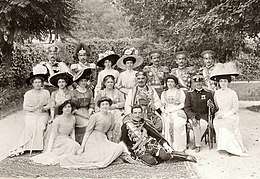
In 1876 Nikola declared war against Turkey; his military reputation was enhanced by the ensuing campaign, and still more by that of 1877/78, during which he captured Nikšić, Bar and Ulcinj. The war resulted in a considerable extension of the Montenegrin frontier and the acquisition of a seaboard on the Adriatic. Nikola justified the war as a revenge for the Battle of Kosovo (1389). In 1876 he sent a message to the Montenegrins in Herzegovina:
- Under Murad I the Serbian Tsardom was destroyed, under Murad V it has to rise again. This is my wish and wish of all of us as well as the wish of almighty God.
The Congress of Berlin in 1878 recognised the independence of Montenegro, and in the succeeding decades Montenegro enjoyed considerable prosperity and stability. Education, communications and the army expanded greatly (the latter with support from Imperial Russia). In 1883 Prince Nikola visited the sultan, with whom he subsequently maintained the most cordial relations; in 1896 he celebrated the bicentenary of the Petrović dynasty, and in the same year he attended the coronation of the Tsar Nicholas II; in May 1898 he visited Queen Victoria at Windsor Castle.
King of Montenegro
| Styles of King Nikola I | |
|---|---|
 | |
| Reference style | His Majesty |
| Spoken style | Your Majesty |
In 1900 Nikola took the style of Royal Highness.
According to Bolati, the Montenegrin court was not grieving that much over the murder of King Alexander Obrenović, as they saw him as an enemy of Montenegro and obstacle to the unification of Serb Lands. "Although it wasn't said openly, it was thought that the Petrović dynasty would achieve [the unification]. All procedures of King Nikola shows that he himself believed that".[6]

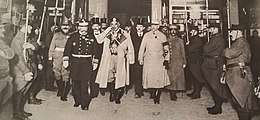
He gave Montenegro its first constitution in 1905 following pressure from a population eager for more freedom. He also introduced west-European style press freedom and criminal law codes. In 1906, he introduced Montenegrin currency, the perper. On 28 August 1910, during the celebration of his jubilee, he assumed the title of king, in accordance with a petition from the Skupština. He was at the same time gazetted field-marshal in the Russian army, an honor never previously conferred on any foreigner except the Duke of Wellington. When the Balkan Wars broke out in 1912 King Nikola was one of the most enthusiastic of the allies. He wanted to drive the Ottomans completely out of Europe. He defied the Powers and captured Scutari despite the fact that they blockaded the whole coast of Montenegro. Again in the Great War which began in 1914 he was the first to go to Serbia's aid to repel the Austrian forces from the Balkan Peninsula.
In January 1916, after the defeat of Serbia, Montenegro was also conquered by Austria-Hungary, and the King fled to Italy and then to France. The government transferred its operations to Bordeaux.
After the end of the First World War, a meeting in Podgorica voted to depose Nikola and annex Montenegro to Serbia. A few months later, Serbia (including Montenegro) merged with the former South Slav territories of Austria-Hungary to form the Kingdom of Serbs, Croats and Slovenes, which was renamed Yugoslavia in 1929. Nikola went into exile in France in 1918, but continued to claim the throne until his death in Antibes three years later. He was buried in Italy. In 1989, the remains of Nikola, his queen Milena, and two of their twelve children were re-buried in Montenegro.
Gallery
 Proclamation of the Kingdom of Montenegro, Cetinje, 28 August 1910
Proclamation of the Kingdom of Montenegro, Cetinje, 28 August 1910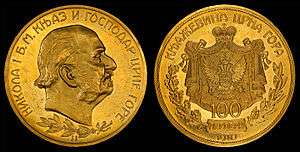 Nikola I depicted on a 100 perper gold coin in 1910 the year he began using the title of king
Nikola I depicted on a 100 perper gold coin in 1910 the year he began using the title of king King Nicholas I, portrait by Italian painter Antonio Mosca, 1912.
King Nicholas I, portrait by Italian painter Antonio Mosca, 1912.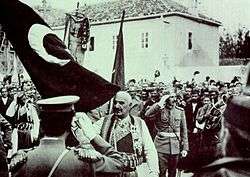 Surrender of Shkodra to Montenegrin King Nikola, in 1913, after the siege
Surrender of Shkodra to Montenegrin King Nikola, in 1913, after the siege Udo Keppler view of King Nicholas, in 1913, during the Balkan Wars, described as "Leonidas of Balkans".
Udo Keppler view of King Nicholas, in 1913, during the Balkan Wars, described as "Leonidas of Balkans". King Nikola I and Victor Emmanuel III, King of Italy, in 1914.
King Nikola I and Victor Emmanuel III, King of Italy, in 1914. King Nikola's Royal Palace in Cetinje
King Nikola's Royal Palace in Cetinje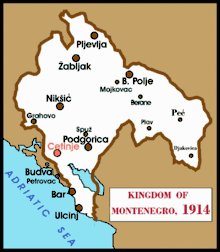 Kingdom of Montenegro in 1914, after the Balkan wars
Kingdom of Montenegro in 1914, after the Balkan wars.jpg) King Nicholas I of Montenegro and Edmund Allenby in 1916
King Nicholas I of Montenegro and Edmund Allenby in 1916 King Nicholas with his family in exile in Lyon
King Nicholas with his family in exile in Lyon The Ćipur Church where he is interred
The Ćipur Church where he is interred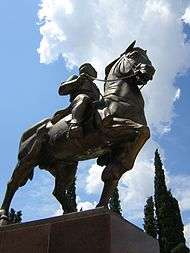 King Nicholas I monument in Podgorica
King Nicholas I monument in Podgorica
Children
| House of Petrović-Njegoš | ||||||||||
|---|---|---|---|---|---|---|---|---|---|---|
| Nicholas I | ||||||||||
|
||||||||||
Five of his daughters were married, each to princes and kings, giving Nikola the nickname "the father-in-law of Europe", a sobriquet he shared with the contemporary King of Denmark.
- Princess Zorka of Montenegro (23 December 1864 – 28 March 1890) she married the then Prince Peter Karađorđević, later King Peter I of Serbia, on 1 August 1883. They had five children.
- Princess Milica of Montenegro (26 July 1866 – 5 September 1951) she married Grand Duke Peter Nicolaievich of Russia on 26 July 1889. They had four children.
- Princess Anastasia of Montenegro (4 January 1868 – 15 November 1935) she married George, Duke of Leuchtenberg on 16 April 1889 and they were divorced on 15 November 1906. They had two children. She remarried Grand Duke Nicholas Nicolaevich of Russia on 29 April 1907.
- Princess Marica of Montenegro (29 March 1869 – 7 May 1885) died at the age of sixteen in St. Petersburg, Russia.
- Princess Elena of Montenegro (8 January 1871 – 28 November 1952) she married the then Crown Prince Victor Emmanuel, later King Victor Emmanuel III of Italy, on 24 October 1896. They had five children.
- Danilo, Crown Prince of Montenegro (29 June 1872 – 24 September 1939) he married Duchess Jutta of Mecklenburg-Strelitz on 15 July 1899. They had no children.
- Princess Anna of Montenegro (18 August 1873 – 22 April 1971) she married Prince Franz Joseph of Battenberg, son of Prince Alexander of Hesse and by Rhine and Julia, Princess of Battenberg, on 18 May 1897. They had no children.
- Princess Sofia of Montenegro (2 May 1876 – 14 June 1876) died at one month old.
- Prince Mirko of Montenegro (17 April 1879 – 2 March 1918) he married Natalija Konstantinović (second cousin to Alexander I of Serbia) on 25 July 1902. They had five sons.
- Princess Xenia of Montenegro (22 April 1881 – 10 March 1960);
- Princess Vjera of Montenegro (22 February 1887 – 31 October 1927)
- Prince Peter of Montenegro (10 October 1889 – 7 May 1932) he married Violet Wegner on 29 April 1924.
The present pretender to the throne is King Nikola's great-grandson Prince Nikola, Prince Michael's son.
Honours
Montenegrin[7]
- Founder and Grand Master of the Order of Saint Peter of Cetinje, 1870[8]
Foreign[7]
.svg.png)
- Grand Cross of the Imperial Order of Leopold, 1870
- Grand Cross of St. Stephen, 1879

- Knight of Saints Cyril and Methodius, with Collar
- Grand Cross of St. Alexander
- Grand Cross of the Order of Bravery
- Grand Cross of the Order of Civil Merit

.svg.png)
- Grand Officer of the Legion of Honour
- Commander of the Order of Agricultural Merit
- Officer of the Ordre des Palmes académiques
.svg.png)
- Knight of the Black Eagle
- Grand Cross of the Red Eagle
.svg.png)
- Knight of the House Order of Fidelity, 1893
- Knight of the Order of Berthold the First, 1893
.svg.png)
.svg.png)
.svg.png)
.svg.png)


.svg.png)
_crowned.svg.png)
- Knight of the Annunciation, 1893
- Grand Cross of Saints Maurice and Lazarus
- Commander of the Military Order of Savoy
.svg.png)
- Collar of the Order of Pope Pius IX
- Grand Cross of the Holy Sepulchre
.svg.png)
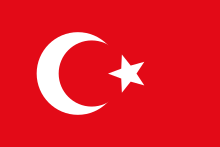
.svg.png)

- Collar of the Order of Carol I
- Grand Cross of the Star of Romania

- Knight of St. Andrew
- Knight of St. Alexander Nevsky
- Knight of the White Eagle
- Knight of St. Anna, 1st Class
- Knight of St. George, 3rd Class, 12 April 1877; 2nd Class, January 1878[14]

.svg.png)
.svg.png)

In popular culture
- King Nikola and the Kingdom of Montenegro are remembered briefly in F. Scott Fitzgerald's The Great Gatsby, where its eponymous main character reminisces on how for his accomplishments and heroic endeavors during the First World War the King confers unto him the highest honor of the Kingdom, the Orderi di Danilo. Gatsby duly presents the medal for his guest to examine which reads on the legend Montenegro, Nicolas Rex and on its reverse: Major Jay Gatsby - For Valour Extraordinary.[17]
- The character of the King in Maurice Chevalier's movie The Merry Widow (1934) is based on Nicholas.
Notes
- ^ After his death, he was initially buried in a Russian Orthodox church in Sanremo. On 1 October 1989, his remains (and the remains of his wife Queen Milena and their daughters Princesses Ksenija and Vjera) were repatriated to Cetinje, SR Montenegro, SFR Yugoslavia where they were given a state funeral and interred in the Ćipur Church near the Cetinje Monastery.
References
- Matica srpska (Novi Sad, Serbia) Zbornik za istoriju, Volume 2, Odeljenje za društvene nauke, Matica srpska, 1970, p. 191: "У том смислу занимљиви су прилози: Николе Петровића, Историјско лес- то, улога и значај Уједин>ене омладине ..."
- Jelena Danilović: Sto godina Opšteg imovinskog zakonika za Crnu Goru, Arhiv za pravne i društvene nauke, 1–2, 2006, str. 233
- Миодраг Јовичић, Лексикон уставности Србије 1804–1918
- Istorijski institut SR Crne Gore u Titogradu 1990, Istoriski zapisi, Volume 63, Istorijski institut u Titogradu, pp. 40–41
- Мартиновић, Нико С. (1954) "Валтазар Богишић и Уједињена омладина српска Зборник" ("Belshazzar Bogišić and the United Serbian Youth") Матице српске (Matica Srpska), volume 9, pages 26–44, in Serbian
- Dragoljub R. Živojinović (1988). Petar I Karađorđević: U otadžbini, 1903–1914. godine. Beogradskĭ izdavačko-grafički zavod. p. 25.
- Acović, Dragomir (2012). Slava i čast: Odlikovanja među Srbima, Srbi među odlikovanjima. Belgrade: Službeni Glasnik. pp. 342–349.CS1 maint: ref=harv (link)
- Romanoff, Prince Dimitri; [colours by Strüwing] (1980). The orders, medals and history of Montenegro. Copenhagen: Bent Carlsen. ISBN 978-8785216274.
- "Ritter-Orden", Hof- und Staatshandbuch der Österreichisch-Ungarischen Monarchie, 1908, pp. 57, 68, retrieved 5 November 2019
- Jørgen Pedersen (2009). Riddere af Elefantordenen, 1559–2009 (in Danish). Syddansk Universitetsforlag. p. 467. ISBN 978-87-7674-434-2.
- Hof- und Staats-Handbuch des Großherzogtum Baden (1896), "Großherzogliche Orden" pp. 63, 77
- Hof- und Staats-Handbuch des Königreich Bayern (1906), "Königliche Orden" p. 7
- 刑部芳則 (2017). 明治時代の勲章外交儀礼 (PDF) (in Japanese). 明治聖徳記念学会紀要. p. 143.
- Russian Imperial Army - King of Montenegro Nikola I Petrovich-Njegos (In Russian)
- "Real y distinguida orden de Carlos III". Guía Oficial de España (in Spanish). 1887. p. 156. Retrieved 21 March 2019.
- Shaw, Wm. A. (1906) The Knights of England, I, London, p. 422
- Fitzgerald, F. Scott (1925). The Great Gatsby. New York: Scribner. p. 170. ISBN 0-684-83042-6.
Sources

Further reading
- Jelena Đurović; Milenija Vračar; Dragica Lompar (2010). Nikola I, gospodar i pjesnik. Centralna Narodna Biblioteka Crne Gore "Đurđe Crnojević". ISBN 978-86-7079-109-1.
- Два Петровића Његоша, Владика Данило Петровић И Кнез Никола I. 1896.
- Перо Вуковић (1910). Књаз Никола I као пјесник: написао Перо Вуковић,... Штампарија К. Ц. Министерства војног.
- King Nikola—personality, work, and time. Crnogorska akademija nauka i umjetnosti. 1998.
- Radoman Jovanović (1977). Politički odnosi Crne Gore i Srbije 1860–1878. Istorijski institut SR Crne Gore.
- Novica Rakočević (1981). Politički odnosi Crne Gore i Srbije: 1903–1918. Istorijski institut SR Crne Gore u Titogradu.
External links
| Wikisource has original works written by or about: Nicholas I of Montenegro |
| Wikimedia Commons has media related to Nicholas I of Montenegro. |
- Video footage of king Nicholas on YouTube (in Croatian)
- Newspaper clippings about Nicholas I of Montenegro in the 20th Century Press Archives of the ZBW
Nicholas I of Montenegro House of Petrović-Njegoš Born: 7 October 1841 Died: 1 March 1921 | ||
| Regnal titles | ||
|---|---|---|
| Preceded by Danilo II |
Prince of Montenegro 13 August 1860 – 28 August 1910 |
Proclaimed king |
| New title | King of Montenegro 28 August 1910 – 26 November 1918 |
Montenegro annexed by Serbia |
| Titles in pretence | ||
| Montenegro annexed by Serbia | — TITULAR — King of Montenegro 26 November 1918 – 1 March 1921 |
Succeeded by Danilo |